

|
The Muromachi period (室町時代) 1336-1573 
The governance of the Muromachi was established in 1336 by Ashikaga Takauji (足利義満), the third shogun, 1368–94, and chancellor, 1394–1408. Muromachi was the district of Kyoto in which his residence was established in 1378. What distinguished the Ashikaga bakufu (幕府) from that of Kamakura (鎌倉時代) was that, whereas Kamakura had existed in equilibrium with the Kyōto court, Ashikaga took over the remnants of the imperial government. Nevertheless, the Ashikaga bakufu was not as strong as the Kamakura had been and was greatly preoccupied with civil war. Not until the rule of Ashikaga Yoshimitsu did a semblance of order emerge. Yoshimitsu allowed the constables, who had had limited powers during the Kamakura period, to become strong regional rulers, later called daimyo (大名). In time, a balance of power evolved between the shogun and the daimyo; the three most prominent daimyo families rotated as deputies to the shogun at Kyoto. Yoshimitsu was finally successful in reunifying the Northern Court and the Southern Court in 1392, but, despite his promise of greater balance between the imperial lines, the Northern Court maintained control over the throne thereafter. The line of shoguns gradually weakened after Yoshimitsu and increasingly lost power to the daimyo and other regional strongmen. As a result, the shogun's decisions about imperial succession became meaningless, and the daimyo backed their own candidates. In time, the Ashikaga family had its own succession problems, resulting finally in the Ōnin War (応仁の乱 Ōnin no Ran, 1467–1477), which left Kyoto devastated and effectively ended the national authority of the bakufu. The power vacuum that ensued launched a century of anarchy. |
|
Nanban trade ( 南蛮貿易, nanban-bōeki), 1543-1641 
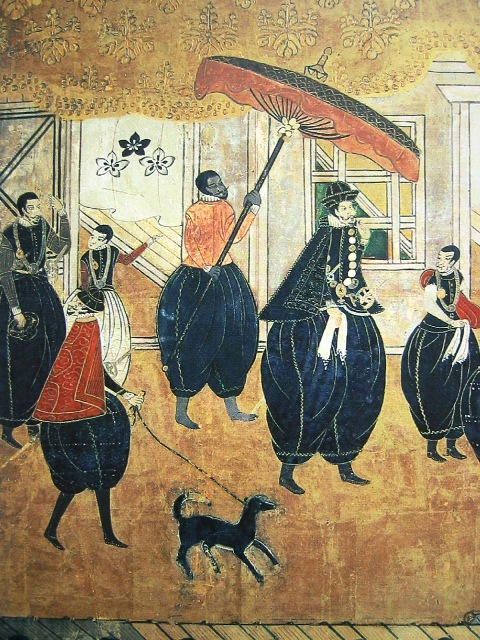
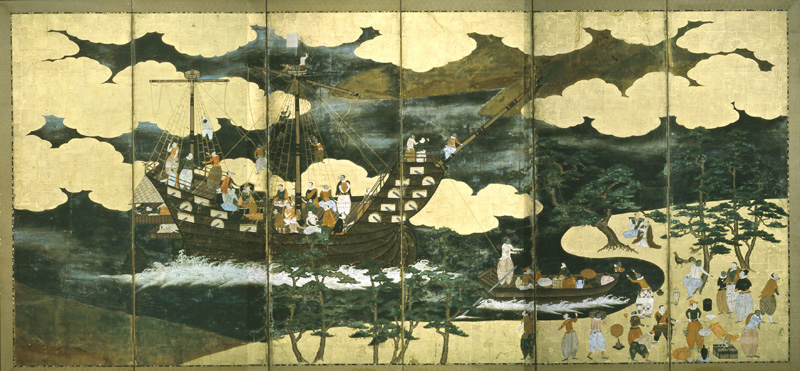
This period lasts for one century, from the arrival of the first Europeans to Japan in 1543, to their near-total exclusion from the archipelago in 1641, under the promulgation of the "Sakoku" Seclusion Edicts. During this time, there was already trade exchanges: around 1515: between Portugal and Goa, from around 1592: Chinese smugglers on junks, Japanese Red Seal Ships (about ten ships every year), from around 1600 Spanish ships from Manila (about one ship a year), from 1609: the Dutch, from 1613: the English (about one ship per year). After the country was pacified and unified by Tokugawa Ieyasu in 1603 however, Japan progressively closed itself to the southern barbarians, mainly because of the growing threat of Christianization. By 1650, except for the trade outpost of Dejima in Nagasaki, for the Netherlands, and some trade with China, foreigners were subject to the death penalty, and Christian converts were persecuted. Travel abroad and the building of large ships was also prohibited. Thence started a period of seclusion, peace, prosperity and mild progress known as the Edo period. |
|
The Edo Period (江戸時代) 1603-1868 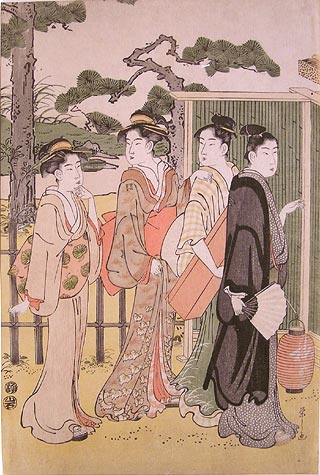

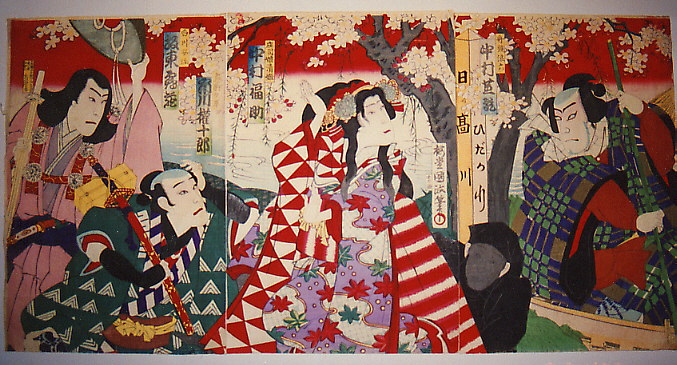
The period is also called Tokugawa period (徳川家康). The period ended with the Meiji Restoration (明治維新). During this period, the administration of the country was shared by over two hundred daimyo (大名). The Tokugawa clan who was the leader of the victorious eastern army in the Battle of Sekigahara, was the most powerful of them, and for fifteen generations monopolized the title of Sei-i Taishōgun (征夷大将軍 often shortened to shōgun). With their headquarters at Edo (present-day Tokyo), the Tokugawa commanded the allegiance of the other daimyo, who in turn ruled their domains with a rather high degree of autonomy. The shogunate carried out a number of significant policies. They placed the samurai class above the commoners: the agriculturists, artisans, and merchants. They enacted sumptuary laws limiting hair style, dress, and accessories. They organized commoners into groups of five, and held all responsible for the acts of each individual. To prevent daimyo from rebelling, the shoguns required them to maintain lavish residences in Edo and live at these residences on a rotating schedule; carry out expensive processions to and from their domains; contribute to the upkeep of shrines, temples, and roads; and seek permission before repairing their castles. Many artistic developments took place during the Edo Period. Most significant among them were the ukiyo-e (浮世絵) form of wood-block print, and the kabuki (歌舞伎) and bunraku (文楽) theaters. Also, many of the most famous works for the koto (琴 or 箏) and shakuhachi(尺八) date from this time period. Throughout the Edo Period, the development of commerce, the rise of the cities, and the pressure from foreign countries changed the environment in which the shoguns and daimyo ruled. In 1868, following the Boshin War (戊辰戦争), the shogunate collapsed, and a new government coalesced around the Emperor. |
|
Isolation Period (鎖国時代, Sakoku) 1635-Jul 8, 1853 

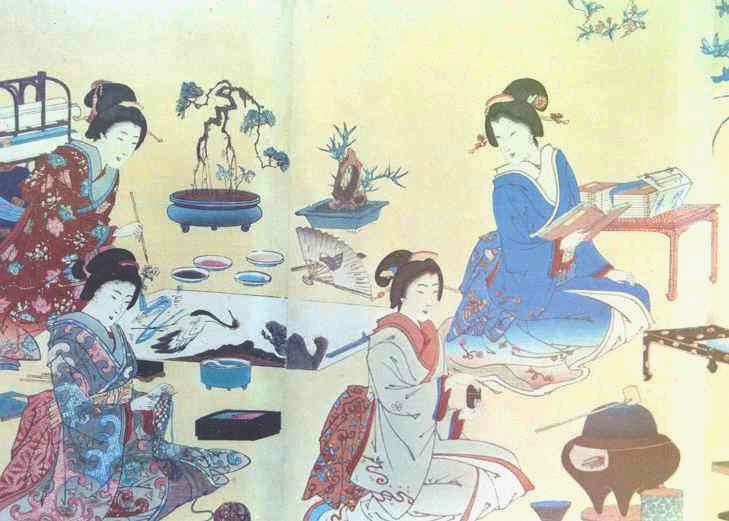
During the early part of the 17th century, the shogunate suspected that the traders and missionaries were actually forerunners of a military conquest by European powers. This caused the shogunate to place foreigners under progressively tighter restrictions. Thus in 1635, the Tokugawa shogunate under Tokugawa Iemitsu placed Japan under a period of isolation or Sakoku ( 鎖国) where no foreigner or Japanese was allowed enter or leave the country. During this time, the government monopolized foreign policy, and expelled traders, missionaries, and foreigners, with the exception of the Dutch and the Chinese merchants restricted to the manmade island of Dejima in Nagasaki Bay and several small trading outposts outside the country. However, during this period, Japan was much less cut off from the rest of the world than is commonly assumed, and some acquisition of western knowledge occurred under the Rangaku (蘭學) system. Japan's isolation only ended on July 8, 1853, when Commodore Matthew Perry of the U.S. Navy steamed into the Bay of Edo (Tokyo), displaying the threatening power of his four warships' (later known as the "Black Ships") Paixhans guns, demanded that Japan open to trade with the West. The following year, at the Convention of Kanagawa (神奈川条約 March 31, 1854), Perry returned with seven ships and forced the Shogun to sign the "Treaty of Peace and Amity", establishing formal diplomatic relations between Japan and the United States. |